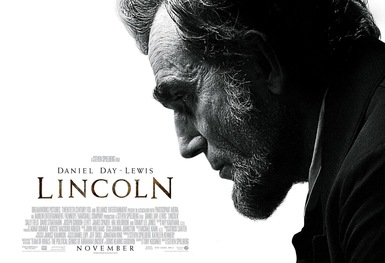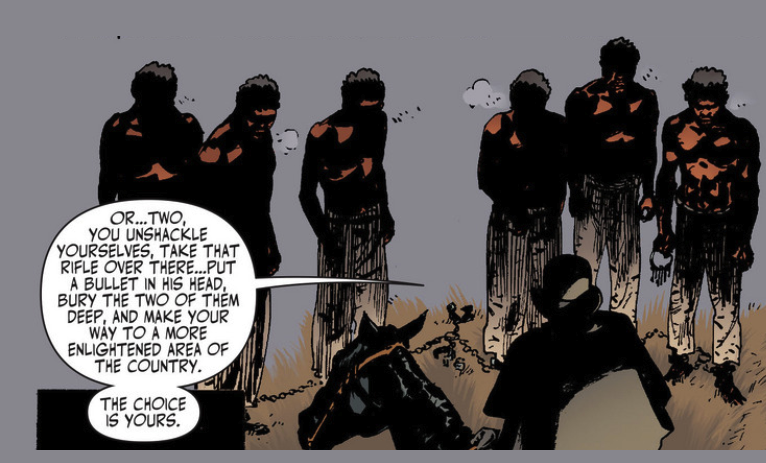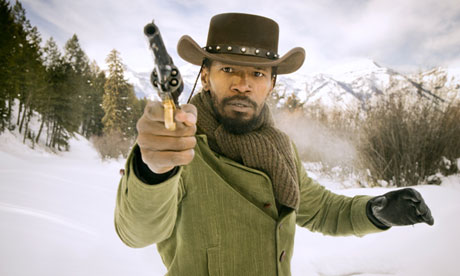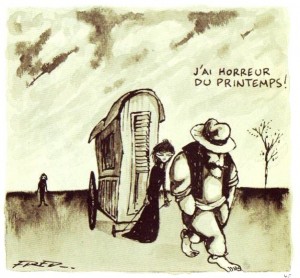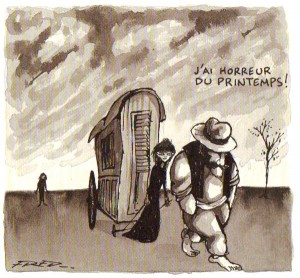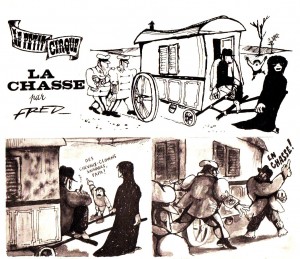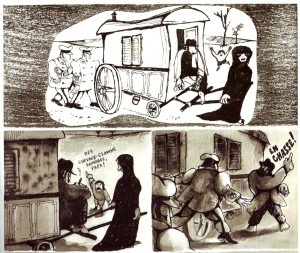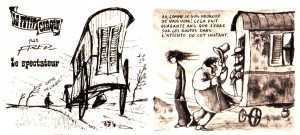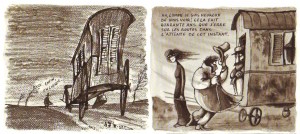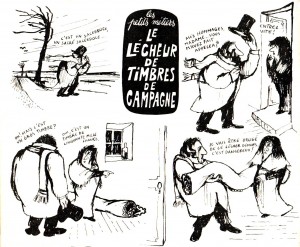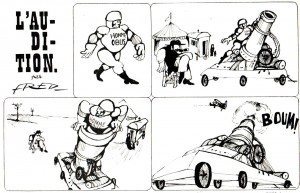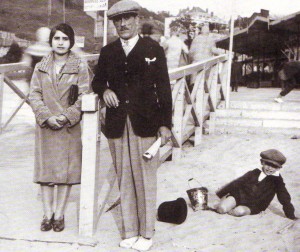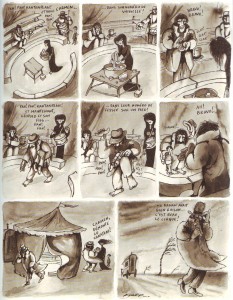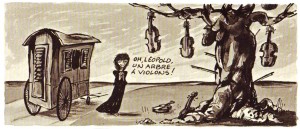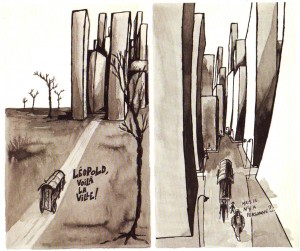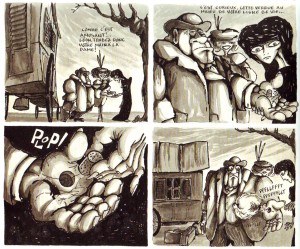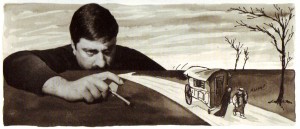In 1981, NBC aired Kent State, a two-hour dramatization of the May 4th shooting at Kent State University. Although it won an Emmy for Outstanding Directing in a Limited Series or a Special, the film is out of print; the easiest way to see it is to watch the poor-quality copy uploaded to the Internet by the film’s own historical consultant.
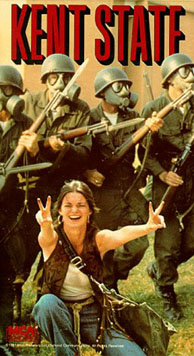
Two years later, four communications professors at Kent State published the results of their study of the film’s effect on faculty, staff, and students. The faculty and staff they surveyed had been present at the university in 1970, but the students had not. The study asked whether viewers perceived docudramas as fact or fiction, and the authors seem to have been surprised by their results:
The students presently at Kent State can scarcely be said to represent a completely uninformed audience. There are symbolic reminders of the event on campus and, far from being forgotten, there is a commemorative ceremony held annually which receives media coverage. For these reasons it would be logical to assume that Kent State students are an informed and therefore critical audience, lacking only firsthand knowledge. Yet, the students used in this study found the Kent State docudrama to be highly believable despite their critical advantage over a completely nai?ve audience. One student said that the film “made the events real.”
This is the perfect simulacrum. People who park their cars on the blacktop where bodies fell require a re-presentation of those deaths, performed ten years after the fact, on a different campus, by no one who was there, in order to be moved.
I watched Kent State, partly as research for my own work but mostly out of curiosity. As a film, it’s just not very good, which may be fortunate; if it functioned effectively as entertainment, if it were skillful and engaging, it might be more obscene than it is.
In the classic sense of obscenity, it exploits the sex lives, real and imagined, of the dead students; Allison Krause lounges in her boyfriend’s shirt and nothing else, sorority girls fall into Bill Schroeder’s lap. Historical consultant J. Gregory Payne wrote about the development of the project, “According to my NBC informants, network programmers felt the screenplay was too political. Apparently the NBC executives preferred a more human focus and had considered developing a romantic theme between some of the principal characters.”
More obscene, to me, is the leaden dialogue. Sandy Scheuer (Talia Balsam) tells another student, “I care about helping people, and my family, and my friends, and grilled cheese sandwiches.” What would be a tolerable, though clumsy, bit of shorthand if it were used to mark the boundaries of a fictional character seems like an injustice when it recreates someone who was real and is dead. It’s not that I believe real people should never be the subject of fiction—I am an eager audience for art that plays with history; but most of the time the historical figures concerned have already left behind a substantial record of their presence in the world. Shakespeare in Love does nothing to diminish Shakespeare while King Lear is still in print, and it matters very little whether the Siegfried Sassoon who appears in Regeneration is strictly accurate when anyone can read Memoirs of a Fox-Hunting Man and know Sassoon as he wished to be known. However, the students of May 4, who were all between nineteen and twenty when they died, are unable to speak for themselves now. Bill Schroeder was a nice kid, an athlete, a Stones fan; he had little time to be anything else.
Worst of the movie’s sins is the contrived dramatic irony that loads almost every line the four students speak: “Big stuff happens and it’s never where you are,” says Jeff Miller (Keith Gordon). It makes the deaths seem prefigured, when the twin tragedies of Kent State were that no one—save the members of Black United Students, who did not attend the Monday demonstration—expected that the Guard would carry live ammunition, and that no one expected Miller, Krause, Scheuer and Schroeder to be the ones to die. The screenplay’s sense of irony brings a false order to the workings of chaos.
The film, though it offers color, motion and sound, is less alive than black-and-white photographs of Allison Krause laughing or Bill Schroeder playing basketball—except for two scenes, both of which get an assist from pop culture contemporary to the shooting. The first is the National Guard rolling into Kent as Crosby, Stills, Nash & Young’s “Ohio” plays; the second is a young Guardsman resting in a troop transport and playing the Grateful Dead’s “Uncle John’s Band” on an acoustic guitar.
The Dead started playing “Uncle John’s Band” live in late 1969, and released it on Workingman’s Dead in June 1970. It is a fantasy of unification, buoyed by three voices in close harmony. By this time the band had been through a traumatic experience at the Altamont speedway: “It was like a nice afternoon in hell,” Jerry Garcia said later. Along with the Byrds’ Sweetheart of the Rodeo, Dylan’s John Wesley Harding, the first two albums by the Band and the work of Gram Parsons, Workingman’s Dead was part of the country rock movement, an attempt to return to the womb of American folk culture. Coming as it did mostly from people who had only a few years earlier attempted to set themselves apart from America in the most dramatic way, this movement could be called a retreat. Considering that they were required to rebuild by hand the America in which they hoped to find a place, you could also call it courageous.
On record “Uncle John’s Band” fulfills itself: the three voices ask for a homecoming and create one as they reach for the chorus. In Kent State, there is only one voice, a small one, and one tinny guitar. The singer is fresh-faced and young, innocent-looking; now he calls softly for a joining of hands, but in less than twenty-four hours he’ll be looking out at the students from behind a gas mask and a gun. Without harmony the song’s requests—Will you come with me? Won’t you come with me?—lose strength and falter, too fragile for their circumstances. People bring pop culture into their lives and invest it with meaning, whether or not it is strong enough to hold up the weight. The night before I wrote this essay, I learned that my father had cancer. I sat in my studio the next day, under his army jacket, and watched the rain fall on Broad Street while “Uncle John’s Band” played, and then I hid my face in my hands.
God damn, well, I declare—have you seen the like?
A more startling intersection between pop and power occurs two scenes earlier. The ROTC building has just caught fire, an event the film does not depict accurately; it shows a group of students lighting the building, then cheering as it burns, when in fact, as my father and many other eyewitnesses have recalled, the students made multiple attempts over the course of roughly twenty minutes to set fire to the building but failed, and had long since wandered away when it exploded into flames.
As the building burns, Professor Glenn Frank (Michael Higgins) says to Professor Ted Arnold (John Getz), “I look at that old pile of burning junk, and all I can see is my old man. And his old man before him, and the grandchildren I don’t have yet. And I wonder what the hell on this earth really matters.” Frank was a real person, a geology professor who saved students’ lives on May 4 by standing between them and the Guard, but this is no real human language; the words assume the shape of profundity but contain nothing. They back away from the building. An assembled crowd of students claps anemically and sings, “Come on baby, light my fire.” The words fade away but the clapping continues. Then it gives way to a low rumble; students and professors turn their heads, there are shots of headlights and huge wheels, and then, as the film cuts to a Dutch-angled shot of a troop transport approaching on the road, we hear the riff that opens “Ohio.”
This is a story my father told me: Gary Lazaroff, one of his college friends, worked at Cleveland’s Gund Arena in the mid-‘70s, and when CSNY passed through on their reunion tour, one of them told him how “Ohio” came to be written. On the fourth of May, Crosby, Stills and Nash were in the process of sobering up from their previous evening’s high when Neil Young appeared. Earlier in the day, he had heard the news from Kent, and had gone out and walked the streets alone, weeping.
I grew up with the song. My father had the So Far LP, and he used to play it every year on the fourth, until the turntable broke and the speakers stopped working. Long before I found out what it meant, it was the sound of a wound, something unresolved, that riff like clenched teeth. At the end of each verse the voices marked out every syllable in the name of the place where I lived: O-hi-o.
The shot goes on for a full minute, as the first transport drives toward us and out of the frame, followed by another, and another, and another. The glare from their headlights blurs the Guardsmen’s faces; astride their Jeeps they look mass-produced. The vehicles seem oversized, out of scale, the embodied will and power of the state. This scene cracks the film’s fac?ade of artificial realism; real life doesn’t have nondiegetic sound, and “Ohio” wasn’t recorded until thirteen days after the Guard arrived in Kent. The effect is conspicuously cinematic, yet nothing else in the film feels as “real.” “In a world that really has been turned on its head,” Guy Debord once wrote, “truth is a moment of falsehood.”
In the end Kent State offered neither a sufficiently comforting myth nor a pleasurable enough spectacle to consume the events that inspired it, as Gone With the Wind and Birth of a Nation consumed Reconstruction. It produced no image more powerful than John Filo’s photograph of Mary Vecchio with her arms outstretched, and no real lasting effect. The damage it did was minimal. It might even have done some good: if a few channel-surfers happened to learn Sandy Scheuer’s name, if Allison Krause became, for a moment, “real” to a student in the Kent State communications program, that doesn’t make up for the years they should have lived, but it’s better, arguably, than being forgotten.
Still, I hate Kent State, for its inaccuracies, its obscenities and its failures; I hate to look at it and yet I want to. I want to confuse the simulacrum with reality, because I know the simulacrum isn’t bound by reality’s rules. The film does not depict the classroom where Bill Schroeder and Dave Wirick sat side by side that Monday morning, but as the students assemble on the Commons I begin to look for my father in the crowds. Again and again I’m drawn in by the promise of fiction—the hope that, this time, the invisible storyteller might change the story.

